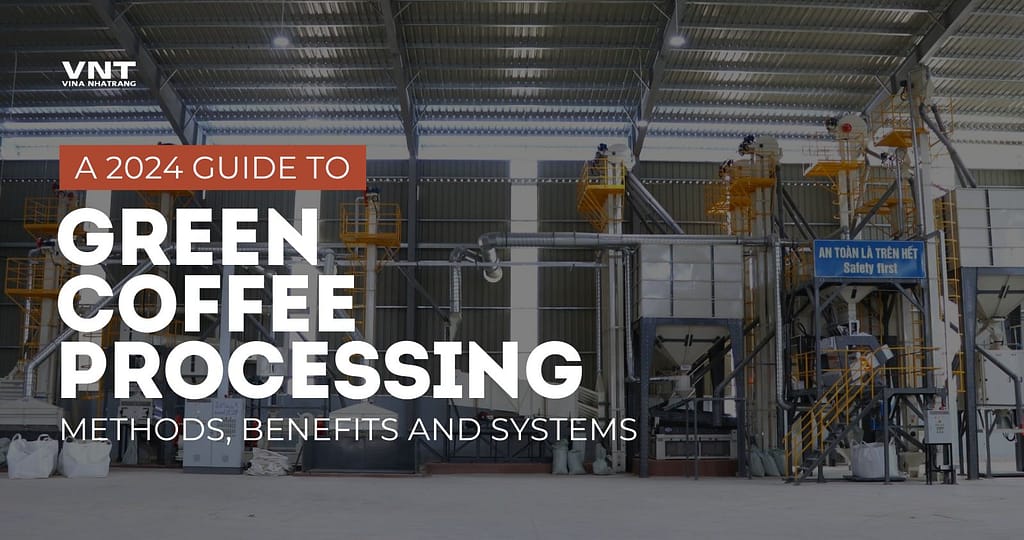Coffee is one of the most widely consumed beverages globally, and the processing methods used to transform raw coffee cherries into the green coffee beans we know play a crucial role in determining the final product’s quality and flavor. The green coffee processing system encompasses various techniques employed to remove the outer layers of the coffee cherries and prepare the beans for roasting. In this comprehensive guide, we’ll explore the different methods used in green coffee processing, their benefits, and the systems involved.
What Are Common Green Coffee Processing Methods?
-
Wet Processing (Washed)
The wet processing method, also known as the washed method, is one of the most widely used techniques for producing high-quality green coffee beans. This method involves:
- Washing: After going through a vibrating sieve to remove excess branches, leaves, and stones, coffee cherries are then directed to a cooling water washing machine for further quality classification and cleaning, preparing them for the pulping process.
-
- Pulping: The fresh coffee cherries are mechanically pulped to remove the outer skin and pulp, leaving behind the coffee beans enclosed in a sticky, parchment-like covering. The VNT‘s Coffee Pulping Machine efficiently removes the fruit flesh (pulp) surrounding the coffee bean, significantly reducing processing time and labor compared to manual methods.
-
- Fermentation: The pulped coffee beans undergo fermentation, which breaks down the remaining mucilage (sticky substance) surrounding the beans.
See how Fermentation plays out in VNT‘s Wet Coffee Processing System
-
- Mucilage Removing: The fermented beans are thoroughly washed to remove any remaining mucilage. Using the VNT‘s Mucilage Coffee Remover Machine in this process ensures consistent high quality, minimizes broken beans, and maintains the natural color of the beans.
-
- Drying: The washed beans are then dried, typically by spreading them on raised beds or using mechanical driers, until they reach the desired moisture content.
Some of the most effective Drying Systems for this method
-
Dry Processing (Natural or Unwashed)
The dry processing method, also called the natural or unwashed method, is often used in regions with limited water resources or for certain coffee varieties. This method involves:
- Drying: The entire coffee cherries are spread out and dried in the sun or mechanical driers until the outer layers become brittle.
See some best Drying Systems for dry processing
-
- Hulling: Once dried, the cherries are mechanically hulled to remove the dried outer layers, leaving behind the green coffee beans. The VNT‘s Huller & Polisher machine efficiently removes the outer husk, protecting the bean from damage and reducing processing time.
-
Semi-washed (Honey)
Processing The semi-washed or honey processing method combines elements of both wet and dry processing. In this method:
- Pulping: Similar to wet processing, the coffee cherries are pulped to remove the outer skin.
- Drying: The pulped coffee beans, still coated with a portion of the mucilage, are then dried like in the dry processing method.
- Hulling: After drying, the remaining layers are mechanically removed, leaving the green coffee beans.
Benefits of Each Processing Method
1. Benefit Of Wet Processing Method:
- Produces a clean, consistent flavor profile
- Removes the fruity and fermented notes associated with dry processing
- Allows for better control over fermentation and drying stages
2. Benefit Of Dry Processing Method:
- Requires less water and equipment, making it more eco-friendly and cost-effective
- Preserves more of the coffee’s natural flavors and aromas
- Suitable for regions with limited water resources
3. Benefit Of Semi-washed (Honey) Processing Method:
- Strikes a balance between the flavors of wet and dry processing
- Retains some of the coffee’s natural fruity and floral notes
- Offers a unique flavor profile distinct from washed or natural coffees
Green Coffee Processing Systems
Green coffee processing systems are designed to efficiently handle the various stages involved in transforming fresh coffee cherries into exportable green coffee beans. These systems typically include different components depending on whether the wet or dry processing method is employed.
Wet Processing Systems:
- Pulping Machines: Mechanical devices that remove the outer skin and pulp from the coffee cherries, leaving behind the beans surrounded by mucilage.
- Fermentation Tanks: Controlled environments where the pulped coffee beans undergo fermentation to break down the remaining mucilage.
- Washing Channels: Specialized channels or tanks where the fermented beans are thoroughly washed to remove any remaining mucilage.
- Drying Systems: Raised beds, mechanical driers, or solar driers used to dry the washed coffee beans to the desired moisture content.
View all machines used in the Wet Coffee Processing System
Dry Processing Systems:
- Drying Systems: Raised beds, mechanical driers, or solar driers used to dry the entire coffee cherries until the outer layers become brittle.
- Hulling Machines: Mechanical devices that remove the dried outer layers (parchment, husk, or hull) from the dried coffee cherries, leaving behind the green coffee beans.
- Sorting and Grading Equipment: Systems that sort and grade the green coffee beans based on factors like size, density, and defects, ensuring consistent quality.
View all machines used in the Dry Coffee Processing System
Both wet and dry processing systems may incorporate additional components such as conveyors, elevators, and storage facilities to streamline the overall process.
Modern green coffee processing systems often incorporate advanced technologies, such as automated controls, moisture monitoring, and energy-efficient drying systems, to improve efficiency, consistency, and sustainability.
Conclusion:
Green coffee processing is a crucial step in the coffee production chain, as it directly impacts the final quality, flavor, and aroma of the coffee we enjoy. By understanding the various processing methods, their benefits, and the systems involved, coffee producers can make informed decisions to meet specific quality requirements and market demands. Whether it’s the clean and consistent flavor profile of wet-processed coffee, the unique and fruity notes of dry-processed coffee, or the balanced profile of semi-washed coffee, the green coffee processing system plays a vital role in creating the diverse and flavorful coffee varieties we love.

